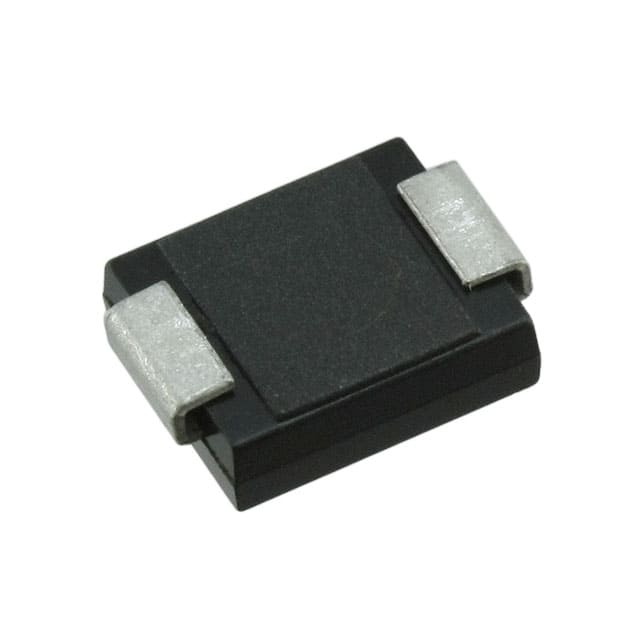SS33 Product Overview
Introduction
SS33 is a semiconductor product that belongs to the category of Schottky diodes. This component is widely used in electronic circuits for its unique characteristics and performance.
Basic Information Overview
- Category: Semiconductor, Schottky diode
- Use: Rectification and voltage clamping in electronic circuits
- Characteristics: Low forward voltage drop, fast switching speed, low reverse leakage current
- Package: SOD-323, SOD-523, SOD-123, SMA, SMB, SMC
- Essence: High-frequency applications, power supply circuits
- Packaging/Quantity: Tape and reel, 3000 pieces per reel
Specifications
- Forward Voltage Drop: Typically 0.3V at 1A
- Reverse Leakage Current: Maximum 10μA at 25°C
- Maximum Operating Temperature: 125°C
- Storage Temperature Range: -55°C to 150°C
- Maximum Reverse Voltage: 30V
Detailed Pin Configuration
The SS33 Schottky diode typically has two pins, anode, and cathode. The pinout configuration is as follows: - Anode (A) - Pin 1 - Cathode (K) - Pin 2
Functional Features
- Fast switching speed allows for efficient operation in high-frequency circuits
- Low forward voltage drop minimizes power loss and heat generation
- Low reverse leakage current ensures minimal power dissipation in reverse bias conditions
Advantages and Disadvantages
Advantages
- Efficient rectification and voltage clamping
- Suitable for high-frequency applications
- Low power dissipation
Disadvantages
- Limited maximum reverse voltage compared to other diode types
- Sensitivity to temperature variations
Working Principles
The SS33 Schottky diode operates based on the principle of the Schottky barrier, which forms at the metal-semiconductor junction. This barrier facilitates fast switching and low forward voltage drop, making it ideal for high-frequency applications.
Detailed Application Field Plans
SS33 Schottky diodes find extensive use in various electronic circuits, including: - Switching power supplies - Voltage clamping circuits - RF applications - DC-DC converters - Reverse polarity protection circuits
Detailed and Complete Alternative Models
- SS32: Lower maximum reverse voltage but similar characteristics
- SS34: Higher maximum reverse voltage with comparable performance
- SS36: Higher maximum reverse voltage and different package options
In conclusion, the SS33 Schottky diode offers efficient rectification and voltage clamping capabilities, making it suitable for a wide range of electronic applications. Its fast switching speed and low forward voltage drop make it an essential component in high-frequency circuits and power supply designs.
Word count: 366
Senaraikan 10 soalan dan jawapan biasa yang berkaitan dengan aplikasi SS33 dalam penyelesaian teknikal
What is SS33?
- SS33 is a type of stainless steel alloy known for its high corrosion resistance and strength.
What are the typical applications of SS33 in technical solutions?
- SS33 is commonly used in marine environments, chemical processing plants, and food processing equipment due to its resistance to corrosion.
Is SS33 suitable for outdoor applications?
- Yes, SS33 is often used in outdoor applications such as architectural structures and transportation equipment due to its ability to withstand harsh environmental conditions.
Can SS33 be welded?
- Yes, SS33 can be welded using common welding techniques, but it may require special precautions to prevent sensitization and maintain its corrosion resistance.
Does SS33 require any special maintenance?
- SS33 generally requires minimal maintenance due to its corrosion-resistant properties, but regular cleaning and inspection are recommended to ensure optimal performance.
What are the limitations of SS33 in technical applications?
- While SS33 offers excellent corrosion resistance, it may not be suitable for applications involving very high temperatures or extreme mechanical stress.
Is SS33 compatible with other materials?
- SS33 can be used in conjunction with other materials such as carbon steel, aluminum, and certain plastics, but compatibility should be carefully considered to avoid galvanic corrosion.
How does the cost of SS33 compare to other materials?
- SS33 is generally more expensive than carbon steel but may offer long-term cost savings due to its durability and low maintenance requirements.
Are there specific design considerations when using SS33 in technical solutions?
- Designers should consider factors such as proper drainage, ventilation, and avoiding crevices where moisture can accumulate to maximize the performance of SS33.
What are the environmental implications of using SS33?
- SS33 is considered environmentally friendly due to its recyclability and long lifespan, making it a sustainable choice for many technical applications.


